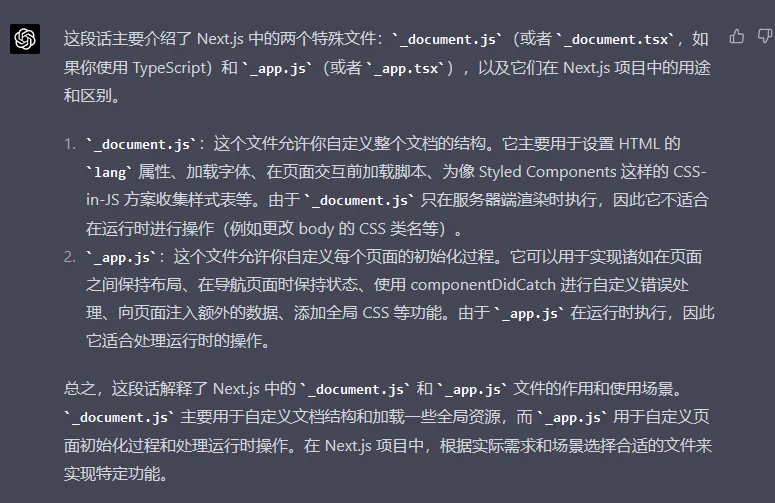补充知识
1、nextjs默认的编译器采用的是webpack5。
2、使用mdx
npm install @next/mdx @mdx-js/loader @mdx-js/react
const withMDX = require('@next/mdx')({
extension: /\.mdx?$/,
options: {
remarkPlugins: [],
rehypePlugins: [],
},
});
const nextConfig = {
pageExtensions: ['ts', 'tsx', 'js', 'jsx', 'md', 'mdx'],
reactStrictMode: true,
async rewrites() {
return [
{
source: '/sitemap.xml',
destination: '/api/sitemap',
},
];
},
webpack: (config) => {
config.resolve.fallback = { fs: false };
return config;
},
};
module.exports = withMDX(nextConfig);
3、import导入顺序规范
在Next.js和其他JavaScript项目中,没有严格的导入顺序规定。但是,遵循一些通用的导入顺序规范可以使代码更加整洁和易于阅读。以下是一种推荐的导入顺序:
- 第三方库和框架(如
react,next,styled-components等) - 组件(如
Layout,Date等) - 工具和辅助函数(如
getSortedPostsData) - 常量和配置文件
- 样式文件(如CSS或Sass模块)
4、什么时候在next.js项目中使用import React from 'react'
-Importing react into pages in next.js (and also React and CRA apps
5、从 Next.js 12 开始,支持使用 ES modules 语法编写配置文件 next.config.js,只需要将其改名为 next.config.mjs 即可。在之前的版本中,只支持使用 CommonJS 语法编写配置文件。
6、next.js中的_app.js和_document.js的区别与联系

7、可视化报告
# 安装@next/bundle-analyzer
pnpm add @next/bundle-analyzer
# 在next.config.mjs中进行相关的配置
# 运行Bundle Analyzer
# 生成交互式的可视化报告展示了你的Next.js应用的bundle大小和构成。
ANALYZE=true npm run build
next.config.mjs中的相关配置
import remarkGfm from 'remark-gfm';
import createMDX from '@next/mdx';
import NextBundleAnalyzer from '@next/bundle-analyzer';
const withMDX = createMDX({
extension: /\.mdx?$/,
options: {
remarkPlugins: [remarkGfm],
rehypePlugins: [],
},
});
// 添加这一行来配置NextBundleAnalyzer
const withBundleAnalyzer = NextBundleAnalyzer({
enabled: process.env.ANALYZE === 'true',
});
export default withBundleAnalyzer(
withMDX({
pageExtensions: ['ts', 'tsx', 'js', 'jsx', 'md', 'mdx'],
reactStrictMode: true,
async rewrites() {
return [
{
source: '/sitemap.xml',
destination: '/api/sitemap',
},
];
},
webpack: (config) => {
config.resolve.fallback = { fs: false };
return config;
},
})
);
8、纪录片